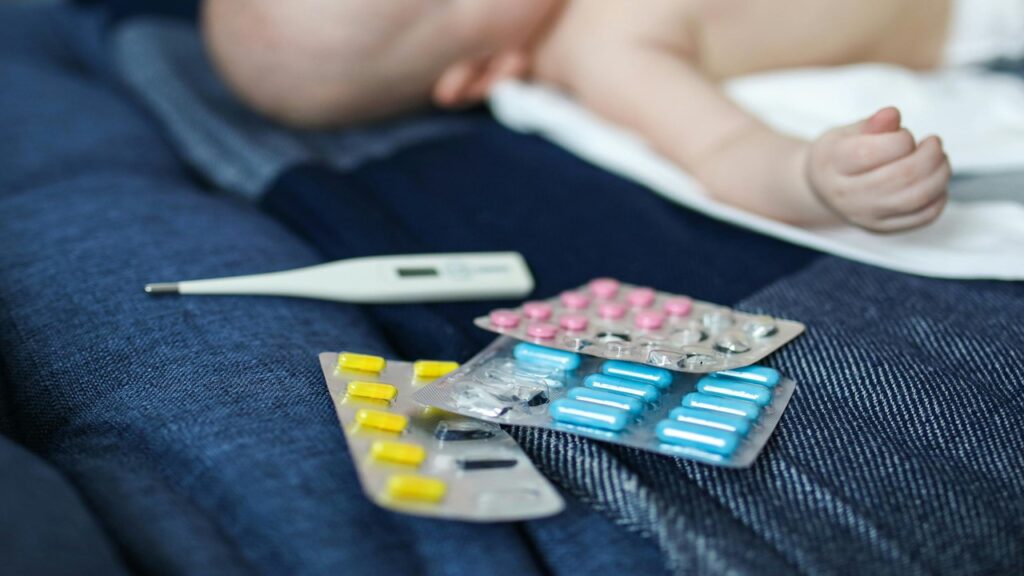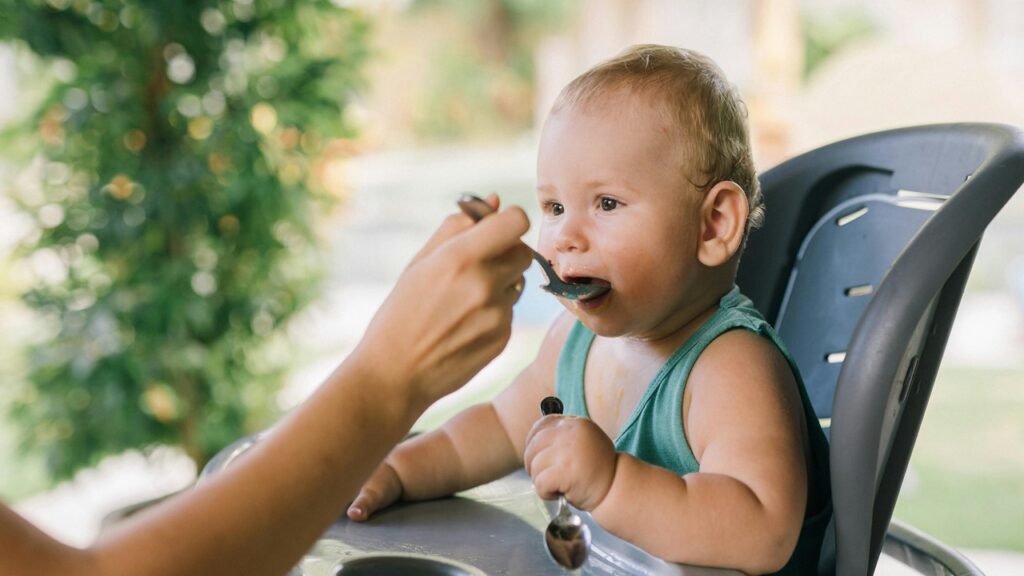To keep a 6-month-old baby happy and learning all day, mix playtime, tummy time, simple games, and quiet moments like reading or singing. This balance helps build their strength, motor skills, and emotional connection.
Spending the day with a 6-month-old can feel like a full-time job, but it’s a chance to bond and help them grow. We’ll share easy ideas for activities that fit into your routine—think songs, toys, and ways to keep them busy while you handle other things. Plus, we’ll talk about how to spot signs when they need a break and how to make the most of those little moments together.
A 6-Month-Old Baby Can Enjoy Activities Like:
- Tummy time with mirrors or toys
- Playing peekaboo or singing songs
- Exploring safe textures and objects
- Watching you do chores
- Reading board books
- Sitting in a high chair during family meals
Your baby is more curious now, more responsive, and eager to explore. At this age, they’re not just lying around anymore—they’re watching, reaching, giggling, and learning all day long. The good news? You don’t need fancy toys or a strict schedule to keep your baby happy and growing.
In this article, we’ll walk through what to expect at this stage, how to build a simple daily rhythm, and over 25 easy activities you can do with your 6-month-old that actually help their development (and don’t take a lot of effort on your part).
Why Structured Play Matters At 6 Months
Structured play doesn’t mean rigid or over-planned. It simply means creating a gentle rhythm in your day when play, sleep, feeding, and bonding naturally flow together. Babies this age thrive on routines that feel familiar and comforting. It helps them make sense of what’s happening around them.
When you include intentional play—even just 15 minutes here and there—you’re doing more than keeping your baby busy. You’re helping them build brain connections, develop muscles, and feel safe to explore. They’re learning every time they grab a spoon or giggle at peekaboo.
And honestly, it helps you too. When you have go-to play ideas or a loose routine, it takes some guesswork out of the day and gives you more freedom to relax and enjoy this stage.
Key Developmental Milestones At 6 Months
At six months, your baby is learning fast and changing almost daily. They’re becoming more aware of their surroundings and starting to interact with the world in new ways. These milestones offer a helpful guide—but remember, every baby is unique and develops at their own pace.
Social And Emotional
Your baby is starting to form stronger bonds. They’ll light up when they see you and may begin to notice when a stranger is nearby. Play becomes more interactive, and you might see more smiles, giggles, and eye contact.
- Recognizes familiar faces
- Smiles more and enjoys interaction
- May show shyness with strangers
Language And Communication
Babies at this stage love the sound of your voice. They often babble and are beginning to connect sounds with meaning. Talking to them regularly helps build early language skills.
- Babbles with sounds like “ah,” “ba,” and “ma”
- Turns toward your voice
- Starts responding to their name
Cognitive Development
This is when your baby becomes a little problem solver. They’ll begin reaching for things, switching toys between hands, and showing signs of understanding that something still exists even when they can’t see it.
- Transfers toys between hands
- Explores with mouth
- Starts to understand object permanence
Motor Skills
Physically, your baby is gaining strength and control. They may start sitting on their own, rolling easily, and pushing up during tummy time. All of this prepares them for crawling and moving more freely.
- Rolls over both ways
- May sit with little or no support
- Rocks on hands and knees, preparing to crawl
25+ Easy And Engaging Activities To Do With Your 6-Month-Old
You don’t need a pile of toys or a complicated plan. Here are simple things you can do with your baby each day:
Tummy Time With A Mirror
Prop a baby-safe mirror in front of your baby during tummy time. Babies love looking at faces—even their own! The mirror keeps them curious and engaged, encouraging head lifting, arm movement, and body awareness. It also gives them feedback on their own expressions.
Peekaboo
Use your hands, a scarf, or a soft cloth to play peekaboo. The moment you disappear and reappear teaches your baby about object permanence. It’s a simple game, but it brings out genuine giggles and helps with early cognitive development.
Read Together
Choose board books with bold colors, big pictures, or different textures. Point to animals, shapes, or faces and describe them aloud. Reading daily builds language skills and gives your baby a chance to focus and bond with you.
Texture Basket
Fill a small container with safe, touchable items like fabric swatches, a soft brush, or a silicone spoon. Let your baby explore each item with their hands and mouth. This kind of sensory play helps with touch sensitivity and hand control.
Sing Nursery Rhymes
Simple songs like “Row, Row, Row Your Boat” or “Old MacDonald” are perfect. Add clapping or gentle movements to make it interactive. Repeating the same songs helps your baby recognize rhythm, words, and routine.
Play With Kitchen Items
Let your baby explore safe utensils like silicone spatulas, plastic cups, or wooden spoons. They’ll enjoy banging, grasping, or just holding something new. This is especially handy while you’re nearby cooking or tidying up.
Water Tray Splashing
Place a baking tray or shallow tub with lukewarm water in front of your baby. Lay them tummy-down with a towel underneath. Splash gently and let them pat the surface. It’s a gentle intro to water play and coordination.
Try Solid Foods
If your baby is showing signs of readiness, start with soft solids like mashed banana or steamed carrot sticks. Let them explore the food with their hands. It’s messy, but it’s a rich sensory and self-feeding experience.
Use A Soft Ball
Roll a plush or lightweight ball toward your baby. They might bat at it, try to grasp it, or follow it with their eyes. This builds hand-eye coordination and encourages reaching and tracking.
Dance With Your Baby
Hold your baby close and move gently to music. Whether it’s a lullaby or a soft beat, they’ll enjoy the rhythm and the closeness. Dancing also helps with body awareness and balance as they’re supported in your arms.
Watch Laundry Or Dishes
Babies love watching repetitive motion. Let them sit in a safe spot while you fold clothes or load dishes. Talk about what you’re doing. “Here’s a soft towel. Now I’m closing the washer.” This builds language and curiosity.
Face-To-Face Time
Sit down at your baby’s level and make eye contact. Smile, stick out your tongue, raise your eyebrows. Babies study faces and expressions closely. It’s a great way to bond and spark communication.
Outdoor Blanket Time
Spread out a clean blanket in a shaded outdoor area. Let your baby lie down or sit up with support. Bring a few toys or just enjoy the breeze and sounds. Being outside adds a whole new layer of sensory input.
Walks In A Stroller
Use a stroller that allows your baby to face outward and take in the sights. Narrate your walk—”That’s a dog!” or “Look at the trees!” It’s great for calm alertness and language exposure.
Play With Bath Toys
Add a few soft, squeezable toys or cups to bath time. Let your baby grab, float, or splash them. It turns a routine task into a sensory experience that’s fun and calming.
Sit-Up Practice With Toys
Support your baby in a seated position using pillows or a soft baby seat. Place a few toys within reach. They’ll start leaning forward, grabbing, and building core strength for sitting on their own.
Interactive Mobiles
Hang safe, soft toys from a play gym or elastic band just above baby’s reach. They’ll stretch, bat, and tug, which helps with arm coordination and muscle control.
Help With Diaper Changes
Turn diaper changes into bonding time. Talk through each step, let them hold a clean diaper or a soft wipe package. Involving them builds trust and predictability.
Observe Cooking
Let your baby sit nearby in a high chair while you cook. Offer a spoon to hold and describe what you’re doing. “This is a red tomato. I’m chopping it now.” It keeps them engaged and learning while you get things done.
Sing During Nap time
Use a short, calming lullaby before each nap. The repetition helps signal that it’s time to sleep. You can hum softly while holding them or sing quietly while rocking.
Offer A Spoon To Self-Feed
Preload a soft spoon with a puree or mashed food and let your baby try to bring it to their mouth. It’s messy but builds independence and coordination.
Family Mealtime Involvement
Include your baby at the table, even if they’re not eating solid foods yet. Let them watch, listen to the conversation, and feel part of the family rhythm.
Time With Other Babies
Arrange safe playtime with another baby, if possible. Your baby might watch, reach for, or smile at the other child. It’s an early form of social learning.
Change Object Baskets Regularly
Rotate toys and objects every few days to keep things fresh. A new basket of safe items can spark curiosity and prevent boredom.
Talk Through Daily Life
Describe your actions in simple terms. “Now we’re putting on socks,” or “Time for your bottle.” It helps your baby connect words to routines and actions over time.
Do You Need A Strict Schedule For A 6-Month-Old?
Not at all. A flexible routine works best. Think of your day in blocks: wake, feed, play, nap, repeat. This gives structure without stress.
Most babies at this age stay awake for 2 to 3 hours at a time and nap two or three times a day. But if they miss a nap or the timing changes, that’s okay. Look for their sleepy cues and go with the flow.
Having familiar rhythms—like a song before sleep or playtime after meals—helps your baby know what to expect. It also makes your day smoother.
Recommended article How To Grocery Shop With A Baby
How To Know If An Activity Is Right For Your Baby
Babies tell us what they like with their body language. If they’re smiling, looking at you, reaching for things, or babbling, they’re interested. That’s a good sign to keep going.
If they turn away, cry, arch their back, or get fussy, it might be time for a break or a change of pace. It doesn’t mean they didn’t enjoy it—just that they’ve had enough for now.
Follow your baby’s lead. Some days they’ll love water play, other days they may prefer a quiet cuddle and book.
FAQs:
How Long Should My Baby Play?
Try 15–30 minutes at a time. A few sessions throughout the day are enough.
Can My Baby Play Alone?
Yes, for short bursts. Stay close, but let them explore independently when they seem content.
Should I Worry If They’re Not Crawling Yet?
No. Many babies don’t crawl until 8 to 10 months. Focus on tummy time and letting them move freely.
Is It Okay To Repeat The Same Activities Daily?
Yes. Babies love repetition. It helps them feel safe and learn faster.
Final Thoughts: Let Curiosity Lead The Way
Every baby is different, and every day will look a little different, too. You don’t need to fill every minute or worry if your day looks messy. The small things you do—talking, singing, playing—matter more than you think.
Your baby doesn’t need perfection. They need you, your presence, and your love. Keep it simple, keep it real, and enjoy the sweet moments you share.
Hi, I’m the voice behind BabyNush — a lover of all things baby, with years of hands-on experience caring for kids and little ones in my life. Growing up around babies taught me the ins and outs of childcare, and now I’m here to share practical tips, how-to guides, and reviews to help make your parenting journey smoother.










